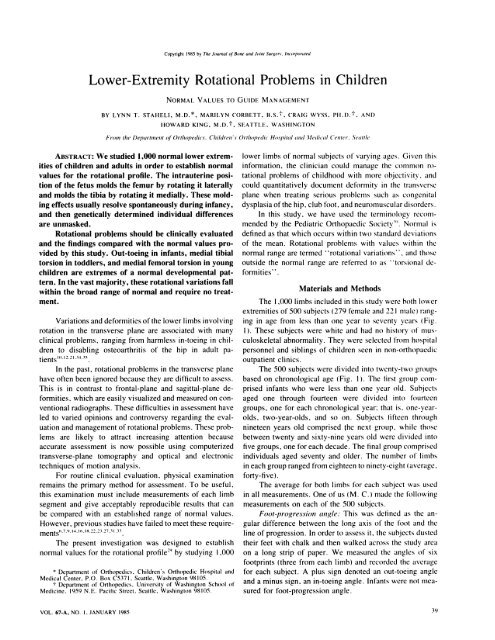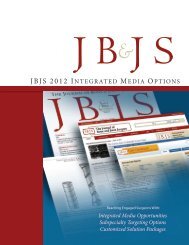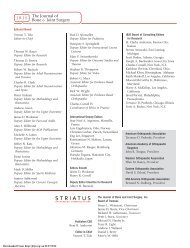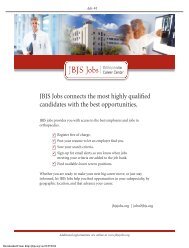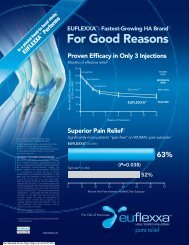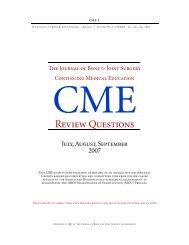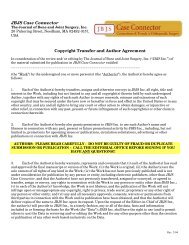Lower-Extremity Rotational Problems in Children - The Journal of ...
Lower-Extremity Rotational Problems in Children - The Journal of ...
Lower-Extremity Rotational Problems in Children - The Journal of ...
You also want an ePaper? Increase the reach of your titles
YUMPU automatically turns print PDFs into web optimized ePapers that Google loves.
ABSTRACT: We studied 1,000 normal lower extrem<br />
ities <strong>of</strong> children and adults <strong>in</strong> order to establish normal<br />
values for the rotational pr<strong>of</strong>ile. <strong>The</strong> <strong>in</strong>trauter<strong>in</strong>e posi<br />
tion <strong>of</strong> the fetus molds the femur by rotat<strong>in</strong>g it laterally<br />
and molds the tibia by rotat<strong>in</strong>g it medially <strong>The</strong>se mold<br />
<strong>in</strong>g effects usually resolve spontaneously dur<strong>in</strong>g <strong>in</strong>fancy,<br />
and then genetically<br />
are unmasked.<br />
determ<strong>in</strong>ed <strong>in</strong>dividual differences<br />
<strong>Rotational</strong> prob'ems should be cl<strong>in</strong>ically evaluated<br />
and the f<strong>in</strong>d<strong>in</strong>gs compared with the normal values pro<br />
vided by this study. Out-toe<strong>in</strong>g <strong>in</strong> <strong>in</strong>fants, medial tibial<br />
torsion <strong>in</strong> toddlers, and medial femoral torsion <strong>in</strong> young<br />
children are extremes <strong>of</strong> a normal developmental pat<br />
tern In the vast majority, these rotational variations fall<br />
with<strong>in</strong> the broad range <strong>of</strong> normal and require no treat<br />
ment.<br />
Variations and deformities <strong>of</strong>the lower limbs <strong>in</strong>volv<strong>in</strong>g<br />
rotation <strong>in</strong> the transverse plane are associated with many<br />
cl<strong>in</strong>ical problems. rang<strong>in</strong>g from harmless <strong>in</strong>-toe<strong>in</strong>g <strong>in</strong> chil<br />
dren to disabl<strong>in</strong>g osteoarthritis <strong>of</strong> the hip <strong>in</strong> adult pa<br />
tients''2'2t3435.<br />
In the past. rotational problems <strong>in</strong> the transverse plane<br />
have <strong>of</strong>ten been ignored because they are difficult to assess.<br />
This is <strong>in</strong> contrast to frontal-plane and sagittal-plane de<br />
formities. which are easily visualized and measured on con<br />
ventional radiographs. <strong>The</strong>se difficulties <strong>in</strong> assessment have<br />
led to varied op<strong>in</strong>ions and controversy regard<strong>in</strong>g the eval<br />
uation and management <strong>of</strong> rotational problems. <strong>The</strong>se prob<br />
hems are likely to attract <strong>in</strong>creas<strong>in</strong>g attention because<br />
accurate assessment is now possible us<strong>in</strong>g computerized<br />
transverse-plane tomography and optical and electronic<br />
techniques <strong>of</strong> motion analysis.<br />
For rout<strong>in</strong>e cl<strong>in</strong>ical evaluation, physical exam<strong>in</strong>ation<br />
rema<strong>in</strong>s the primary method for assessment. To be useful,<br />
this exam<strong>in</strong>ation must <strong>in</strong>clude measurements <strong>of</strong> each limb<br />
segment and give acceptably reproducible results that can<br />
be compared with an established range <strong>of</strong> normal values.<br />
However, previous studies have failed to meet these require<br />
ments@794SR222327333.<br />
<strong>The</strong> present <strong>in</strong>vestigation was designed to establish<br />
normal values for the rotational pr<strong>of</strong>ile29 by study<strong>in</strong>g I .000<br />
* Department <strong>of</strong> Orthopedics. <strong>Children</strong>s Orthopedic Hospital and<br />
Medical Center, P.O. Box C537l. Seattle. Wash<strong>in</strong>gton 98105.<br />
1@Department <strong>of</strong> Orthopedics. University <strong>of</strong> Wash<strong>in</strong>gton School <strong>of</strong><br />
Medic<strong>in</strong>e. 1959 N.E. Pacific Street. Seattle, Wash<strong>in</strong>gton 98105.<br />
Copyright 1985 by <strong>The</strong> <strong>Journal</strong> <strong>of</strong> Bone and Jo<strong>in</strong>t Surgery. Itmcorporated<br />
lower limbs <strong>of</strong> normal subjects <strong>of</strong> vary<strong>in</strong>g ages. Given this<br />
<strong>in</strong>formation, the cl<strong>in</strong>ician could manage the comtiion ro<br />
tational problems <strong>of</strong> childhood with more objectivity . and<br />
could quantitatively document deformity <strong>in</strong> the transverse<br />
plane when treat<strong>in</strong>g serious problems such as congenital<br />
dysplasia <strong>of</strong>the hip. club foot. and neuromuscular disorders.<br />
In this study. we have used the terni<strong>in</strong>ology reco<strong>in</strong><br />
mended by the Pediatric Orthopaedic Society1. Normal is<br />
def<strong>in</strong>ed as that which occurs with<strong>in</strong> two standard deviations<br />
<strong>of</strong> the mean. <strong>Rotational</strong> problems with values with<strong>in</strong> the<br />
normal range are termed rotational variations'<br />
outside the normal range are referred to as @torsional de<br />
formities''.<br />
@ and those<br />
VOL. 67-A, NO. I. JANUARY 1985<br />
<strong>Lower</strong>-<strong>Extremity</strong> <strong>Rotational</strong> <strong>Problems</strong> <strong>in</strong> <strong>Children</strong><br />
NORMAL. VALUES TO GUIDE MANAGEMENT<br />
BY LYNN T. STAHELI, M.D.*, MARILYN (ORBETT, B.S.t. CRAIG WYSS. P11.1).1', AND<br />
HOWARD KING. M.D.t, SEATTLE. WASHINGTON<br />
!@?Ofli the Deporttnetmt <strong>of</strong> Oit/iopedie.s. CImi/dre,is ()ii/mopedi Hospital iou! ,%1('(/i((,I Center. Seattle<br />
Materials and Methods<br />
<strong>The</strong> I .000 limbs <strong>in</strong>cluded <strong>in</strong> this study were both lower<br />
extremities <strong>of</strong>SOO subjects (279 female and 221 male rang<br />
<strong>in</strong>g <strong>in</strong> age from less than one year to seventy years (Fig.<br />
1). <strong>The</strong>se subjects were white and had no history <strong>of</strong> mus<br />
culoskeletal abnormality. <strong>The</strong>y were selected from hospital<br />
personnel and sibl<strong>in</strong>gs <strong>of</strong> children seen <strong>in</strong> non-orthopaedic<br />
outpatient cl<strong>in</strong>ics.<br />
<strong>The</strong> 500 subjects were divided <strong>in</strong>to twenty-two groups<br />
based on chronological age (Fig. I ). <strong>The</strong> first group Colli<br />
prised <strong>in</strong>fants who were less than one year old. Subjects<br />
aged one through fourteen were divided <strong>in</strong>to fourteen<br />
groups, one for each chronological year; that is. one-year<br />
olds, two-year-olds. and so on. Subjects fifteen through<br />
n<strong>in</strong>eteen years old comprised @henext group. while those<br />
between twenty and sixty-n<strong>in</strong>e years old were divided <strong>in</strong>to<br />
five groups, one for each decade. <strong>The</strong> f<strong>in</strong>al group comprised<br />
<strong>in</strong>dividuals aged seventy and older. <strong>The</strong> number <strong>of</strong> limbs<br />
<strong>in</strong> each group ranged from eighteen to n<strong>in</strong>ety-eight (average.<br />
forty-five).<br />
<strong>The</strong> average for both limbs fc'r each subject was used<br />
<strong>in</strong> all measurements. One <strong>of</strong> us (M. C.) made the follow<strong>in</strong>g<br />
measurements on each <strong>of</strong> the 500 subjects.<br />
Foot-progression angle: This was def<strong>in</strong>ed as the an<br />
gular difference between the long axis <strong>of</strong> the foot and the<br />
l<strong>in</strong>e <strong>of</strong> progression. In order to assess it, the subjects dusted<br />
their feet with chalk and then walked across the study area<br />
on a long strip <strong>of</strong> paper. We measured the angles <strong>of</strong> six<br />
footpr<strong>in</strong>ts (three from each limb) and recorded the average<br />
for each subject. A plus sign denoted an out-toe<strong>in</strong>g angle<br />
and a m<strong>in</strong>us sign. an <strong>in</strong>-toe<strong>in</strong>g angle. Infants were not <strong>in</strong>ca<br />
sured for foot-progression angle.<br />
39
40 I.. T. STAEIII.I, MARIlYN (ORBETT. (‘RAft;WYSS. AND HOWARD KIN(I<br />
RI)<br />
C<br />
a<br />
0<br />
0<br />
.0 E<br />
C<br />
50<br />
25<br />
0<br />
(n500)<br />
.5 1 2 3 4 5 6 7 8 9 10 11 12 131415- 203040506070<br />
19<br />
years <strong>of</strong> age<br />
Fi. I<br />
Distribution <strong>of</strong> suh@ects accord<strong>in</strong>g to the twenty-two age groups studied. Forty-etght subjects soere less than one year old: elesen. one to tsoo years<br />
old: twenty-tour. two) to three @earsold: and 50)Ofl. <strong>The</strong>re were ut) subjects between sixteen and tssemty sears old <strong>in</strong> the soad@ population. Subjects<br />
who were more than twenty years old were divided <strong>in</strong>to) six ten-year age groups. as shown.<br />
Hip rotation: This was measured with the patient prone<br />
and the knees flexed to 90 degrees. With the pelvis level.<br />
the thighs were rotated to the angle that would be ma<strong>in</strong>ta<strong>in</strong>ed<br />
by gravity alone. We photographically recorded the posi<br />
Lions <strong>of</strong> the legs us<strong>in</strong>g a camera located distally and directed<br />
cephalad <strong>in</strong> l<strong>in</strong>e with the axes <strong>of</strong> the thighs. Medial and<br />
lateral rotations were measured with a goniometer on an<br />
eight by ten-<strong>in</strong>ch (twenty by twenty-five-centimeter) neg<br />
ative image projected by a photographic enlarger.<br />
Thigh—footci@igle(1,1(1(lFli,'/@? (.)f the lraFl.vtnalleol(ir a.vis:<br />
<strong>The</strong>se were used to determ<strong>in</strong>e transverse-plane rotational<br />
variations <strong>of</strong> the tibia and foot. <strong>The</strong>y were measured with<br />
the subject prone. the knees flexed to 90 degrees. and the<br />
ankles <strong>in</strong> neutral position. <strong>The</strong> center po<strong>in</strong>t <strong>of</strong>each malleolus<br />
was marked, and these po<strong>in</strong>ts were jo<strong>in</strong>ed by a l<strong>in</strong>e across<br />
the plantar aspect <strong>of</strong> the heel. This l<strong>in</strong>e was used to ap<br />
proximate the transmalleolar axis. A photograph was made<br />
with the camera positioned above each foot and aimed <strong>in</strong><br />
l<strong>in</strong>e with the tibiae. <strong>The</strong> measurements made from the pro<br />
jected photographic negative were as follows: ( 1) thigh-foot<br />
angle —¿the angular difference between the axis <strong>of</strong> the foot<br />
and the axis <strong>of</strong> the thigh. and (2) angle <strong>of</strong> the transmalleolar<br />
axis —¿the angular difference between a l<strong>in</strong>e projected<br />
toward the heel at right angles to the transmalleolar axis<br />
and the axis <strong>of</strong> the thigh. In-toe<strong>in</strong>g angles were given neg<br />
ative values and out-toe<strong>in</strong>g angles. positive values.<br />
Intro -Exam<strong>in</strong>er (111(1lizter-Exarni,u'r Variability<br />
Standard deviations and mean errors were computed<br />
to assess the <strong>in</strong>tra-exam<strong>in</strong>er and <strong>in</strong>ter-exam<strong>in</strong>er variabilities<br />
<strong>in</strong> the measurements <strong>of</strong> medial and lateral rotation <strong>of</strong> the<br />
hip. thigh-foot angle, and angle <strong>of</strong> the transnialleolar axis<br />
made on the photographic negatives and by direct cl<strong>in</strong>ical<br />
exam<strong>in</strong>ation (Table I).<br />
Intra-exam<strong>in</strong>er variability was assessed by one exam<br />
<strong>in</strong>er (a pre-medical student). who made photographic mea<br />
surements <strong>of</strong> three subjects (a twenty-seven-year-old man.<br />
a twenty-two-year-old man. and a forty-six-year-old worn<br />
an) on three separate occasions over a two-week period.<br />
<strong>The</strong> average standard deviations. <strong>in</strong> degrees. for the pho<br />
ErrorPhotographicMedial<br />
.48Lateral rotation3.812.652.07I<br />
rotation4.243.481.521.11Thigh-foot<br />
angle3.652%1.671.24Angle<br />
thetransmalleolar <strong>of</strong><br />
16ICl<strong>in</strong>ical*Medial axis4.073.222.<br />
rotation4.9))3.33Lateral<br />
rotation5.814.50Thigh-foot<br />
angle6.31)5.02Angle<br />
thetransmalleolar <strong>of</strong><br />
axis8.906.78<br />
TABL,F; I<br />
INTER-EXAMINER ANt) IN1RA-Ex.ASIINI:R \‘ARisitii iTtilS<br />
IN THE MEASUREMENTS (IN [)EaRI:rs 01 Mt:I)t.st<br />
AND LATERAl. ROTATION (IF TIlE Hip. TEIIGII.FooT AN(i I<br />
AND ANGIE OF THE TRANsSIAI,I.Ioi AR Axis<br />
Inter—Lx<br />
Standard Mean<br />
I)eviationani<strong>in</strong>erErrorI<br />
ntra—Ex<br />
Standard Meami<br />
I)eviation@<strong>in</strong>itner<br />
* Intra—exam<strong>in</strong>er variability <strong>in</strong> cl<strong>in</strong>ical nieasuremcmits so as not loves<br />
tigated.<br />
tographic measurements were 2.07 for n@edialrotation. I .52<br />
for lateral rotation. 1.67 for thigh-foot angle. and 2. 16 for<br />
transmalleolar axis. <strong>The</strong> over-all average standard deviation.<br />
<strong>in</strong> degrees, for all measuretilents was I .86. <strong>The</strong> mean errors<br />
for these measurements were 1.48. 1.11. 1.24. and 1.56<br />
for medial and lateral rotation <strong>of</strong> the hip. thigh-foot angle.<br />
and angle <strong>of</strong> the transmalleolar axis. respectively.<br />
THE JOURNAL OF BONE AND JOINT SURGERY
Inter-exam<strong>in</strong>er variability was assessed by six exam<br />
<strong>in</strong>ers (the director <strong>of</strong> the orthopaedic departtiient. two or<br />
thopaedic residents. two medical students, and a pre<br />
medical student). Each <strong>of</strong> the six exam<strong>in</strong>ers measured the<br />
medial and lateral rotation <strong>of</strong> the hip. thigh-foot angle. and<br />
transmalleolar axis on the same three subjects (a twenty<br />
seven-month-old girl. an eleven-year-old boy. and a forty<br />
one-year-old woman). In addition, we compared the <strong>in</strong>ca<br />
surements made on the photographic negatives and dur<strong>in</strong>g<br />
20â€<br />
@ ., 0<br />
100<br />
0<br />
@100<br />
0<br />
LOWER-EXTREMITY ROTATIONAl. PROBlEMS IN (IIII.I)REN<br />
0<br />
0<br />
0<br />
@ 0<br />
P@,<br />
0<br />
0 a<br />
the cl<strong>in</strong>ical exam<strong>in</strong>ations. Cl<strong>in</strong>ical measurements <strong>of</strong> rotation<br />
<strong>of</strong> the hip were made with a gravity goniometer. and the<br />
thigh-foot angle and transmalleolaraxis were measured with<br />
a protractor. <strong>The</strong> standard deviations and mean errors for<br />
the photographic and cl<strong>in</strong>ical measurements are shown <strong>in</strong><br />
Table I. An F test <strong>of</strong> equality <strong>of</strong> variances <strong>of</strong> the photo<br />
graphic and cl<strong>in</strong>ical measurements showed no significant<br />
differences (p > 0.05). Thus. <strong>in</strong>ter-exam<strong>in</strong>er variabilities<br />
<strong>in</strong> the photographic and cl<strong>in</strong>ical measurements were similar.<br />
@ ,@bH@:<br />
@ 2SD<br />
@0<br />
±L.<br />
@ :@: . D<br />
0 0<br />
0<br />
0<br />
1 3 5 7 9 11 13 15-19<br />
a.<br />
0<br />
0 25D<br />
0<br />
0 0 Q ‘¿I<br />
1 3 5 7 9 11 13 15-19 30's 50's 70+<br />
0<br />
0<br />
a<br />
\<br />
0<br />
30's 50's 70+<br />
Figs. 2—Athrough 2—F:<strong>The</strong> five measurements plotted as the mean salites plus or tuititis Isoa stamdard deviations for each <strong>of</strong> the tsoentv-two age<br />
groups. <strong>The</strong> solid l<strong>in</strong>es show the mean changes with age: the shaded areas. the miormualranges: the solid circles. the mueamimeasuremilents for the different<br />
age groups: and the open circles. plus or m<strong>in</strong>us two standard deviations t@r the samiiemean miicasureniemits.<br />
Fig. 2-A: Foot-progression angle.<br />
80°<br />
60°<br />
40°<br />
VOL. 67-A, NO. I. JANUARY 19115<br />
0<br />
0<br />
Age (years)<br />
Fi. 2-A<br />
0@<br />
0<br />
Age (years)<br />
Fii@.2-B<br />
Medial rotation <strong>of</strong> the hip <strong>in</strong> male subjects.<br />
0<br />
0<br />
0<br />
2 SD<br />
2 SD<br />
41
@<br />
42 I.. T. STAFIELI. MARIlYN (ORBETI. (RAI(i WYSS, ANI) HOWARD KING<br />
F<strong>in</strong>d<strong>in</strong>gs<br />
Data on male and female subjects were compared for<br />
each Of the five measurements: foot-progressIon angle. me<br />
dial and lateral rotation <strong>of</strong> the hip. thigh-foot angle. and<br />
angle <strong>of</strong> the transmalleolar axis. Medial rotation <strong>of</strong> the hip<br />
was significantly different (p < ().05 <strong>in</strong> male and female<br />
subjects. <strong>The</strong>refore. separate graphs for medial rotation<br />
were prepared. one for each sex. For all other measurements<br />
there were fl() significant diftCrences (p > ().05 between<br />
80°<br />
@ 0<br />
T\<br />
60°<br />
40°<br />
20°<br />
0<br />
100°<br />
80°<br />
60°<br />
40°<br />
20°<br />
0<br />
0<br />
0<br />
0<br />
0<br />
a<br />
a 0<br />
@ 0<br />
0<br />
0<br />
3<br />
0<br />
00<br />
@0<br />
0<br />
a<br />
0<br />
0<br />
male and female subjects. and their data were pooled for<br />
analysis.<br />
For each <strong>of</strong> the twenty-two age groups we computed<br />
the mean and standard deviation <strong>of</strong> each <strong>of</strong> the measure<br />
ments. <strong>The</strong>se calculations were plotted on graphs (Figs.<br />
2-A through 2-F) show<strong>in</strong>g the means and the po<strong>in</strong>ts for plus<br />
and m<strong>in</strong>us two standard deviations as functions <strong>of</strong> the mean<br />
ages for the twenty-two groups. Smooth l<strong>in</strong>es were drawn<br />
through the data po<strong>in</strong>ts by comput<strong>in</strong>g quadratic functions<br />
us<strong>in</strong>g a non-l<strong>in</strong>ear least-squares fitt<strong>in</strong>g algorithm.<br />
0<br />
0 0<br />
a 0<br />
5 11 13 15-19<br />
Age (years)<br />
Fi( .<br />
Niedmal rotation oil the hip mifcmiiale suh@ects.<br />
O'9<br />
0<br />
3 5 7 9 11 13 15-19 30's 50's 70+<br />
Age (years)<br />
Fi.. 2-I)<br />
I.ateral rotatiomi(if the limp<strong>in</strong> mii@mIe and femiialesubjects conib<strong>in</strong>ed<br />
0<br />
0<br />
0<br />
0<br />
a<br />
70+<br />
2 SD<br />
2 SD<br />
2 SD<br />
THEJOURNALOF BONEANDJOINTSURGERY
@<br />
@<br />
LOWER-EXTREMITY ROTATIONAl. PROBLEMS IN (HII.DRIN<br />
Foot-progression angle (Fig. 2-A): This angle was<br />
greatest and most variable dur<strong>in</strong>g <strong>in</strong>fancy. Dur<strong>in</strong>g childhood<br />
and adult life it showed little change. with the mean re<br />
ma<strong>in</strong><strong>in</strong>g approximately + 10 degrees and the normal range<br />
be<strong>in</strong>g between —¿ 3 and + 20 degrees.<br />
Medicil rotation <strong>of</strong> the hip (Figs. 2-B and 2-C): S<strong>in</strong>ce<br />
medial rotation was greater <strong>in</strong> female than <strong>in</strong> male subjects<br />
by a mean difference <strong>of</strong> 7 degrees. separate graphs for the<br />
sexes were constructed. Medial rotation was greatest <strong>in</strong> early<br />
childhood and then decl<strong>in</strong>ed throughout later childhood and<br />
adulthood. From the middle <strong>of</strong> childhood on. for tiiale sub<br />
jects the mean was about 50 degrees and the normal range<br />
0<br />
0<br />
0<br />
was from 25 to 65 degrees. For female subjects the mean<br />
was about 40 degrees and the normal range was froni I5 to<br />
60 degrees.<br />
Lateral Fotatioll @?tt11(' hi/) (Fig. 2—D): Unlike medial<br />
rotation, lateral rotation <strong>of</strong> the hip showed flO sex-related<br />
difference. so all values were pooled. Lateral rotation was<br />
greatest dur<strong>in</strong>g <strong>in</strong>fancy. decl<strong>in</strong>ed throughout childhood. and<br />
then rema<strong>in</strong>ed relatively constant dur<strong>in</strong>g adult IlIC. From<br />
the middle <strong>of</strong>childhood on. the mean was about 45 degrees<br />
and the normal range was from 25 to 65 degrees.<br />
Thigh-foot angle (Fig. 2-E): This angle <strong>in</strong>creased and<br />
became less variable throughout childhood. From the middle<br />
0<br />
0<br />
0 0<br />
0<br />
0<br />
0 a<br />
2 SD<br />
40°<br />
20°<br />
-20°<br />
-40°<br />
0<br />
0<br />
3 5 7 9 11 13 15-19 30s 50s 70+<br />
0<br />
0<br />
0<br />
Age (years)<br />
i)<br />
Ft(. 2-I:<br />
Thmiih—fonitatigle.<br />
0<br />
Age (years)<br />
0<br />
Fmo. 2@F<br />
Angle <strong>of</strong> the transnial leolar axis.<br />
a<br />
0<br />
0<br />
0 0<br />
0<br />
0<br />
0<br />
@<br />
@<br />
0<br />
0<br />
0<br />
0<br />
0<br />
2 SD<br />
VOL.67-A,NO. I. JANUARY1985<br />
0<br />
0<br />
.0<br />
3 5 7 9 11 13 15-19<br />
rz.<br />
0<br />
0<br />
0<br />
‘¿I<br />
2 SD<br />
0 2SD<br />
43
@<br />
44 L. T. STAHELI, MARILYN CORBETT, CRAIG WYSS, AND HOWARD KING<br />
ErrorPresent<br />
* Averages are <strong>in</strong> parentheses.<br />
Inter-Exani<strong>in</strong>erIntra-Exani<strong>in</strong>erStandardMeanStandard<br />
MeanL)eviationErrorDeviation<br />
studyPhotographic3.81-4.252.65-3.481.52-2.16<br />
1.11-1.56(3.941(3.081(l.86(<br />
(1.35)Cl<strong>in</strong>ical.<br />
<strong>in</strong>vestigated(6.481(4.911Other<br />
over-all4.9()-8.9()3.33-6.78Not<br />
studiesAshton<br />
1.70(hip)(8.40)Bocmne<br />
et al.6.01-I<br />
TABLE II<br />
RANGES AND AVERAGES* FOR INTER-EXAMINER AND INTRA-EXAMINER<br />
VARIABILITIES IN MEASUREMENT (IN DEGREES) DETERMINED IN THIS ANt) OTHER STUDIES<br />
.4(shoulder. and Aze&0.2-I<br />
.0)forearm. elbow .I I<br />
hip.knee. wrist.<br />
footBooneankle.<br />
al.1.5-4.60.6-1.4(shoulder.<br />
et<br />
elbow.(2.9)(1.0)wrist.<br />
knee.tOot)Ekstrand<br />
hip.<br />
al.'2.5-5.5(hip. et<br />
ankle)(3.7)Low knee.<br />
(elbow. wrist 14.4-7. 7<br />
(5.62)3.3-6.3 (4.6)0.69-3.69<br />
<strong>of</strong> childhood on, the mean angle rema<strong>in</strong>ed approximately<br />
10 degrees and the range <strong>of</strong> normal values was from —¿ 5<br />
to 30 degrees.<br />
Angle <strong>of</strong> the transnialleolar O.V1S(Fig . 2-F): <strong>The</strong> angle<br />
<strong>of</strong> this axis <strong>in</strong>creased and became slightly less variable with<br />
age. <strong>The</strong> mean angles and the normal ranges <strong>of</strong> the trans<br />
malleolar axis were greater than those <strong>of</strong> the thigh-foot<br />
angle. From the middle <strong>of</strong> childhood on. the mean approx<br />
imated 20 degrees and the ranges <strong>of</strong> normal were from zero<br />
to 45 degrees.<br />
Discussion<br />
As shown <strong>in</strong> Table II, the <strong>in</strong>ter-exam<strong>in</strong>er and <strong>in</strong>tra<br />
exam<strong>in</strong>er variabilities, standard deviations, and mean errors<br />
were used to compare the exam<strong>in</strong>er variabilities <strong>in</strong> the cur<br />
rent study with the f<strong>in</strong>d<strong>in</strong>gs <strong>in</strong> other reliability studies'5<br />
<strong>The</strong> f<strong>in</strong>d<strong>in</strong>gs <strong>in</strong> our study compare favorably with the values<br />
reported <strong>in</strong> other studies (Table II). For the <strong>in</strong>tra-exam<strong>in</strong>er<br />
variabilities <strong>in</strong> the present study. the over-all average stan<br />
dard deviation was with<strong>in</strong> the range <strong>of</strong> the average standard<br />
deviations <strong>in</strong> other studies ( 1.0 to 37)2.3.5.215<strong>The</strong> mean error<br />
values for these variabilities were also with<strong>in</strong> the range <strong>of</strong><br />
0.6 to 3.3 found <strong>in</strong> Low's study2. For the <strong>in</strong>ter-exam<strong>in</strong>er<br />
variabilities <strong>in</strong> the current study. the over-all standard de<br />
viations were with<strong>in</strong> the range reported <strong>in</strong> other studies<br />
(over-all average standard deviations rang<strong>in</strong>g from 2.9 to<br />
8.4)225. and the mean errors were with<strong>in</strong> the range <strong>of</strong> 3.3<br />
to 6.3 reported by Low2. As would be expected, <strong>in</strong> the<br />
present study the <strong>in</strong>ter-exam<strong>in</strong>er variabilities were greater<br />
than the <strong>in</strong>tra-exam<strong>in</strong>er variabilities, a f<strong>in</strong>d<strong>in</strong>g that was con<br />
sistent with those <strong>in</strong> previous studies22.<br />
Inter-exam<strong>in</strong>er variabilities <strong>of</strong> the measurements that<br />
0.06-3.3<br />
(2.24) (1.9)<br />
were made on the photographs were similar to those <strong>of</strong> the<br />
measurements that were made dur<strong>in</strong>g cl<strong>in</strong>ical exam<strong>in</strong>ations.<br />
Thus, similar accuracy <strong>of</strong> measurement can be obta<strong>in</strong>ed<br />
us<strong>in</strong>g either method.<br />
Foot-Progression Angle<br />
In the current study. the foot-progression angle varied<br />
with age (Fig. 2-A). In young children the mean was higher<br />
and the range was broader than <strong>in</strong> older children. This early<br />
relative out-toe<strong>in</strong>g was apparently due to the greater lateral<br />
rotation <strong>of</strong> the hip <strong>in</strong> this age group. Dur<strong>in</strong>g adult life lateral<br />
rotation aga<strong>in</strong> occurred, presumably due to progressive loss<br />
<strong>of</strong> medial rotation <strong>of</strong> the hip.<br />
<strong>The</strong> data for the foot-progression angle <strong>in</strong> the current<br />
study were consistent with those <strong>in</strong> previous reports. Scrut<br />
ton and Robson, <strong>in</strong> their study <strong>of</strong> fifty normal children.<br />
found that <strong>in</strong> 94 per cent <strong>of</strong> the children who were one to<br />
three years old the mean was + 6 degrees and the range<br />
was from —¿ 5 to + 15 degrees. while <strong>in</strong> the children who<br />
were older than four the mean was 4 degrees and the range<br />
was from —¿ 2 to + 12 degrees. Eighteen per cent <strong>of</strong> these<br />
fifty children had <strong>in</strong>-toe<strong>in</strong>g on one side27. Schwartz et al.,<br />
<strong>in</strong> a study <strong>of</strong> adults. found that the mean was between 5<br />
and 9 degrees, with more out-toe<strong>in</strong>g occurr<strong>in</strong>g <strong>in</strong> subjects<br />
who were more than sixty years old26.<br />
<strong>The</strong> foot-progression angle may be normal <strong>in</strong> patients<br />
with torsional deformity because medial femoral torsion is<br />
<strong>of</strong>ten associated with compensat<strong>in</strong>g lateral tibial torsion.<br />
This association was found by Fabry et al.75 <strong>in</strong> 30 per cent<br />
<strong>of</strong> the patients <strong>in</strong> their series and it was also found by<br />
Kobyhiansky et al.7 <strong>in</strong> their study <strong>of</strong>dried<br />
from the same limbs.<br />
tibiae and femora<br />
THEJOURNALOF BONEANDJOINTSURGERY
Femur<br />
Our study showed that <strong>in</strong> early <strong>in</strong>fancy lateral rotation<br />
<strong>of</strong> the femur is greater than medial rotation, but that with<br />
advanc<strong>in</strong>g age lateral rotation decreases while medial ro<br />
tation <strong>in</strong>creases (Figs. 2-B. 2-C, and 2-D). <strong>The</strong> f<strong>in</strong>d<strong>in</strong>gs <strong>in</strong><br />
this study were consistent with previous f<strong>in</strong>d<strong>in</strong>gs for mean<br />
values dur<strong>in</strong>g childhood4°@53.15.25but <strong>in</strong> addition provided<br />
a range <strong>of</strong> normal values. This normal range is great at all<br />
ages. with the upper limit <strong>of</strong> medial rotation be<strong>in</strong>g about<br />
65 degrees <strong>in</strong> male subjects and 60 degrees <strong>in</strong> female sub<br />
jects (Figs. 2-B and 2-C). <strong>The</strong> lower limit <strong>of</strong> lateral rotation<br />
is about 25 degrees for both sexes.<br />
Severity <strong>of</strong> medial femoral torsion may be graded as<br />
follows: mild if medial rotation is between 70 and 80 degrees<br />
and lateral rotation is between 10 and 20 degrees (two or<br />
three standard deviations from the mean). moderate if me<br />
dial rotation is between 80 and 90 degrees and lateral ro<br />
tation is between zero and 10 degrees (three or four standard<br />
deviations), and severe if medial rotation is greater than 90<br />
degrees and no lateral rotation is possible (more than four<br />
standard deviations). <strong>The</strong> degree <strong>of</strong> jo<strong>in</strong>t laxity <strong>in</strong>fluences<br />
these values, and both medial rotation and lateral rotation<br />
will be <strong>in</strong>creased <strong>in</strong> a child with jo<strong>in</strong>t laxity.<br />
<strong>The</strong> relationship between rotation <strong>of</strong> the hip and ra<br />
diographically measured femoral anteversion was studied<br />
by Staheli et al.32. A reasonable correlation was found,<br />
although other factors, such as acetabular <strong>in</strong>cl<strong>in</strong>ation. can<br />
affect rotation <strong>of</strong> the hip.<br />
Tibia<br />
Tibial rotation is def<strong>in</strong>ed as the relationship beween<br />
the axis <strong>of</strong> rotation <strong>of</strong> the knee and the transmalleolar axis2'.<br />
In 1909. le Damany measured the rotation <strong>in</strong> 100 dried<br />
tibiae'1. In the newborn. the average angle <strong>of</strong> the trans<br />
malleolar axis was 4 degrees <strong>of</strong> medial rotation. <strong>The</strong>reafter.<br />
lateral rotation gradually <strong>in</strong>creased throughout childhood<br />
40e<br />
200<br />
0<br />
-20°<br />
-40°<br />
VOL. 67-A, NO. I. JANUARY 1985<br />
LOWER-EXTREMITY ROTATIONAl. PROBLEMS IN (I-IILDREN 45<br />
Ft;. 3<br />
until the mean rotation was 23 degrees <strong>of</strong> lateral rotation.<br />
with a range <strong>of</strong> zero to 40 degrees <strong>in</strong> @idults.<br />
Later studies confirmed this early work. Nachlas oh<br />
served that medial rotation <strong>of</strong> the tibia is common <strong>in</strong> the<br />
orangutan and gorilla. and suggested that medial tihial tor<br />
sion is an atavistic variation4. Hutter and Scott measured<br />
forty adult skeletons and found that the mean lateral tihial<br />
rotation was 21 degrees on the right and 19 degrees Ofl the<br />
leftâ€. <strong>The</strong>y then studied fifty children, two to three years<br />
old, and found that 30 per cent had <strong>in</strong>-toe<strong>in</strong>g. usually due<br />
to medial tibial torsion. <strong>The</strong> prevalence was 8 to 10 per cent<br />
<strong>in</strong> the five to seven-year age group and 8 to 9 per cent <strong>in</strong><br />
early adolescence, with a nearly equal sex distribution. <strong>The</strong>y<br />
also found that 3 per cent <strong>of</strong> 200 adults whom they studied<br />
showed persistence <strong>of</strong> significant medial torsion. hut this<br />
was not def<strong>in</strong>ed. <strong>The</strong>y considered this to be a serious prob<br />
lem <strong>in</strong> about 1 per cent.<br />
Wynne-Davies. us<strong>in</strong>g a special caliper to measure tihial<br />
rotation <strong>in</strong> normal adults5@' found that it ranged froni zero<br />
to 40 degrees <strong>of</strong> lateral rotation. the mean be<strong>in</strong>g 20 degrees.<br />
Khermosh et al. studied tibial rotation <strong>in</strong> 230 children <strong>in</strong><br />
<strong>in</strong>fancy and early childhood and found that the mean lateral<br />
rotation was 2 degrees at birth and 10 degrees at the age <strong>of</strong><br />
five years'4. Staheli and Engel used a caliper method to<br />
survey 160 normal children5. <strong>The</strong>y found a gradual <strong>in</strong>crease<br />
from 5 to 14 degrees <strong>of</strong> lateral rotation between the ages <strong>of</strong><br />
one and thirteen years. while Ritter et al. found the <strong>in</strong>crease<br />
to be from 4 degrees at birth to I 1 degrees at two years@.<br />
Malekafzali and Wood, <strong>in</strong> 200 adult subjects. found the<br />
normal range to be from 7 to 20 degrees <strong>of</strong> lateral rotation.<br />
with a mean <strong>of</strong> 14 degrees21.<br />
<strong>The</strong> current study demonstrated that the angle <strong>of</strong> the<br />
transmalleolar axis and the thigh-foot angle become pro<br />
gressively larger lateral angles throughout growth (Figs.<br />
2-E and 2-F). <strong>The</strong> f<strong>in</strong>d<strong>in</strong>gs relative to the angle <strong>of</strong> the trans<br />
malleolar axis were comparable with those found <strong>in</strong> other<br />
studies. From the middle <strong>of</strong> childhood through adult life.<br />
. . .<br />
1 3 5 7 9 11 13 15-19 30's 50's<br />
Age (years)<br />
Comiiparison <strong>of</strong> the angle <strong>of</strong> the transmalleolar axis ITMA) amidthe thigh-fiat angle (TFA).<br />
70+<br />
IMA<br />
TFA
46 L. T. STAHELI, MARILYN CORBETT, CRAIG WYSS, AND HOWARD KING<br />
the normal range is from about zero to 45 degrees <strong>of</strong> lateral<br />
rotation, with a mean <strong>of</strong> 25 degrees.<br />
<strong>The</strong> thigh-foot angle is a composite measurement that<br />
reflects rotation <strong>of</strong> both the tibia and the h<strong>in</strong>d part <strong>of</strong> the<br />
foot3 . This angle roughly parallels the angle <strong>of</strong> the trans<br />
malleolar axis, but its mean value is lower (Fig. 3).<br />
<strong>The</strong> thigh-foot angle is easier to measure than the angle<br />
<strong>of</strong> the transmalleolar axis and is the most practical mea<br />
surement <strong>of</strong> the usual torsional deformity. However, for<br />
more complex torsional deformities, such as the torsion<br />
associated with a club foot, measurements <strong>of</strong> both the trans<br />
malleolar axis and the thigh-foot angle are useful. <strong>The</strong>se<br />
measurements clarify the anatomical location <strong>of</strong> the de<br />
formity. Thus, torsional deformity <strong>of</strong> the tibia is assessed<br />
by the angle <strong>of</strong> the transmalleolar axis; deformity <strong>of</strong> the<br />
h<strong>in</strong>d part <strong>of</strong> the foot is assessed by the difference between<br />
the angle <strong>of</strong> the transmalleolar axis and the thigh-foot angle;<br />
a comb<strong>in</strong>ed deformity <strong>of</strong> both the tibia and the h<strong>in</strong>d part <strong>of</strong><br />
the foot, by the thigh-foot angle; and f<strong>in</strong>ally, deformity <strong>of</strong><br />
the middle and distal portions <strong>of</strong> the foot, by the difference<br />
between the cl<strong>in</strong>ical measurements <strong>of</strong>the h<strong>in</strong>d and fore parts<br />
<strong>of</strong> the foot.<br />
Foot<br />
Deformities <strong>of</strong> the foot were not assessed <strong>in</strong> this study.<br />
<strong>The</strong> most common foot deformities affect<strong>in</strong>g the rotational<br />
pr<strong>of</strong>ile are metatarsus adductus produc<strong>in</strong>g <strong>in</strong>-toe<strong>in</strong>g and the<br />
hypermobile flat foot produc<strong>in</strong>g out-toe<strong>in</strong>g.<br />
Lateral rotation caused by eversion <strong>of</strong> the foot is see<br />
ondary to jo<strong>in</strong>t laxity or muscle imbalance. Such foot de<br />
formities are detectable dur<strong>in</strong>g the physical exam<strong>in</strong>ation and<br />
should be the last entries <strong>in</strong> the rotational pr<strong>of</strong>ile.<br />
Conclusions<br />
Dur<strong>in</strong>g <strong>in</strong>fancy. the rotational pr<strong>of</strong>ile appears to be<br />
References<br />
<strong>in</strong>fluenced by the effects <strong>of</strong> <strong>in</strong>trauter<strong>in</strong>e mold<strong>in</strong>g. <strong>The</strong> hips<br />
are flexed and laterally rotated <strong>in</strong> utero, result<strong>in</strong>g <strong>in</strong> greater<br />
lateral than medial rotation <strong>of</strong> the hips and femora. <strong>The</strong> feet<br />
are medially rotated, produc<strong>in</strong>g medial rotation <strong>of</strong> the tibia<br />
and sometimes metatarsus adductus. <strong>The</strong> spontaneous res<br />
olution <strong>of</strong> mold<strong>in</strong>g results <strong>in</strong> equalization <strong>of</strong> medial and<br />
lateral rotation <strong>of</strong> the hip, lateral rotation <strong>of</strong> the tibia, and<br />
decreas<strong>in</strong>g variability <strong>in</strong> the foot-progression angle dur<strong>in</strong>g<br />
the second year <strong>of</strong> life.<br />
Genetic factors effect the rotational pr<strong>of</strong>ile dur<strong>in</strong>g early<br />
childhood. Medial femoral torsion becomes evident at the<br />
age when medial rotation is greatest. Cont<strong>in</strong>ued lateral ro<br />
tation <strong>of</strong> the tibia corrects residual medial tibial-torsion an<br />
gulation.<br />
Dur<strong>in</strong>g late childhood, medial rotation <strong>of</strong> the hip di<br />
m<strong>in</strong>ishes, correct<strong>in</strong>g <strong>in</strong>-toe<strong>in</strong>g due to femoral torsion. Con<br />
t<strong>in</strong>ued lateral rotation <strong>of</strong> the tibia, however, may aggravate<br />
a lateral tibial-torsion deformity. Dur<strong>in</strong>g adult years. the<br />
rotational pr<strong>of</strong>ile is relatively constant except for medial<br />
rotation <strong>of</strong> the hip, which decreases, presumably due to a<br />
generalized loss <strong>of</strong> jo<strong>in</strong>t mobility with age.<br />
<strong>The</strong> graphs show<strong>in</strong>g normal values for the rotational<br />
pr<strong>of</strong>ile <strong>of</strong> the lower limbs will allow the cl<strong>in</strong>ician to deter<br />
m<strong>in</strong>e the location and severity <strong>of</strong> torsional problems. In the<br />
past, many <strong>in</strong>fants and children with normal rotational val<br />
ues were treated with spl<strong>in</strong>ts. braces, exercises, or even<br />
surgery.<br />
Such treatment is both harmful to the child and ex<br />
pensive for the parents.<br />
In evaluat<strong>in</strong>g children with torsional deformity. the<br />
potential for long-term disability <strong>in</strong> the absence <strong>of</strong> treatment<br />
and the risks <strong>of</strong> treatment should be weighed. Non-operative<br />
treatments are usually <strong>in</strong>effective. <strong>Rotational</strong> osteotomies<br />
<strong>of</strong> the femur or tibia are effective but are associated with<br />
significant complication rates.<br />
I. ASHTON.B. B.: PICKLES.BARRIE;and RoLl.. J. W.: Reliability <strong>of</strong> Gonionietric Measurements <strong>of</strong> Hip Motion <strong>in</strong> Spastic Cerebral Palsy. Devel.<br />
Med. and Child Neurol. . 20: 87-94. 1978.<br />
2. BOONE. D. C. . and AZEN. S. P.: Normal Range <strong>of</strong> Motion <strong>of</strong> Jo<strong>in</strong>ts <strong>in</strong> Male Subjects. J. Bone and Jo<strong>in</strong>t Surg. , 61-A: 756-759, July 1979.<br />
3. BooNE, D. C.: AZEN, S. P.:<br />
<strong>The</strong>r.. 58: 1355-1360. 1978.<br />
LIN, C.-M.; SPENCE. CAROl.: BARON. CAROl.: and LEE. LYNN: Reliability <strong>of</strong> Goniometric Measurements. Phys.<br />
4. Coos, VAt.ERIE:DONATO.GERALDINE:HOUSER.CAROlYN:and BLECK.E. E.: Normal Ranges<strong>of</strong> Hip Motion <strong>in</strong> Infants Six Weeks, Three Months<br />
and Six Months <strong>of</strong> Age. Cl<strong>in</strong>. Orthop.. 110: 256-260, 1975.<br />
5. EKSTRAND.JAN: WIKTORSSON.MARGARETA:OBERG. BIRGITTA:and GIL[.QUIST.JAN: <strong>Lower</strong> <strong>Extremity</strong> Goniometric Measurements: A Study to<br />
Determ<strong>in</strong>e <strong>The</strong>ir Reliability. Arch. Phys. Med. and Rehab.. 63: 171-175. 1982.<br />
6. ENGEI..G. M.. and STAHELI.L. 1.: <strong>The</strong> Natural History <strong>of</strong> Torsion and Other Factors Influenc<strong>in</strong>g Gait <strong>in</strong> Childhood. A Study <strong>of</strong> the Angle <strong>of</strong><br />
Gait, Tibial Torsion, Knee Angle. Hip Rotation. and Development <strong>of</strong> the Arch <strong>in</strong> Normal <strong>Children</strong>. Cl<strong>in</strong>. Orthop.. 99: 12-17. 1974.<br />
7. FABRY, G.: Torsion <strong>of</strong> the Femur. Acta Orthop. Belgica. 43: 454-459. 1977.<br />
8. FABRY. GUY: MACEWEN. G. D.: and SHANDS. A. R. . JR.: Torsion <strong>of</strong> the Femur. A Follow-up Study <strong>in</strong> Normal and Abnormal Conditions.<br />
Bone and Jo<strong>in</strong>t Surg.. 55-A: 1726-1738. Dec. 1973.<br />
9. HAAS,S. S. Epps. C. H., JR.; and ADAMS.J. P.: Normal Ranges <strong>of</strong> Hip Motion <strong>in</strong> the Newborn. Cl<strong>in</strong>. Orthop.. 91: 114-I 18. 1973.<br />
J.<br />
10. HALPERN. A. A.: TANNER. JOSEPH:and RINSKY,LAWRENCE.:Does Persistent Fetal Femoral Anteversion Contribute to Osteoarthritis? A Prelim<strong>in</strong>ary<br />
Report.Cl<strong>in</strong>.Orthop..145:213-216.1979.<br />
II. HUTTER.C. G.. JR.. and SCOTT.WALTER:Tibial Torsion. J. Bone and Jo<strong>in</strong>t Surg.. 31-A: 511-518, July 1949.<br />
12. INSAI.L. JOHN: FALVO, K. A.: and WISE, D. W.: Chondromalacia Patellae. A Prospective Study. J. Bone and Jo<strong>in</strong>t Surg.. 58-A: 1-8, Jan. 1976.<br />
13. KATE. B. R.. and ROBERT. S. L.: <strong>The</strong> Angle <strong>of</strong> Femoral Torsion. J. Anat. Soc. India. 12: 8-lI. 1963.<br />
14. KUERMOSH.O. LLOR,G.: and WEISSMAN,S. L.: Tibial Torsion <strong>in</strong> <strong>Children</strong>. Cl<strong>in</strong>. Orthop.. 79: 25-31. 1971.<br />
15. KINGSLEY, P. C. , and OLMSTED. K. L.: A Study to Determ<strong>in</strong>e the Angle <strong>of</strong> Anteversion <strong>of</strong> the Neck <strong>of</strong> the Femur. J. Bone and Jo<strong>in</strong>t Surg..<br />
30-A:745-751.July1948.<br />
16. KNITTEL.GUNTER,and STAHELI.L. T.: <strong>The</strong> Effectiveness <strong>of</strong>Shoe Modificationsfor lntoe<strong>in</strong>g. Orthop. Cl<strong>in</strong>. North America. 7: 1019-1025. 1976.<br />
17. KOBYLIANSKY.E.: WEISSMAN. S. L.: and NATHAN. H.: Femoral and Tihial Torsion. A Correlation Study <strong>in</strong> Dry Bones. InternaL. Orthop.. 3:<br />
145-147, 1979.<br />
18. LANIER. J. C.: <strong>The</strong> lntoe<strong>in</strong>g Child. Treatment with a Simple Orthopedic Appliance. J. Florida Med. Assn.. 58: 19-23. Dec.<br />
19. LEDAMANY.P.: La torsion du tibia. Normale. pathologique. expérimentale. J. anal. physiol.. 45: 598-615. 1909.<br />
1971.<br />
20. Low. J. L.: <strong>The</strong> Reliability <strong>of</strong> Jo<strong>in</strong>t Measurement. Physiotherapy. 62: 227-229. 1976.<br />
THE JOURNAL OF BONE AND JOINT SURGERY
LOWER-EXTREMITY ROTATIONAL PROBLEMS IN CHILDREN 47<br />
21. MACEWEN. G. D., and SHANDS. A. R.. JR.: <strong>Rotational</strong> and Angulation Def@rIi1ities <strong>of</strong> the <strong>Lower</strong> <strong>Extremity</strong> <strong>in</strong> Childhood. Orthopedics. 2: 66-<br />
70. April 1960.<br />
22. MCSWEENY. ANTHONY: A Study <strong>of</strong> Femoral Torsion <strong>in</strong> <strong>Children</strong>. J. Bone and Jo<strong>in</strong>t Surg.. 53-B(I): 90-95. 1971.<br />
23. MALEKAFzALI, SAEED. and WooD. M. B.: Tibial Torsion —¿A Simple Cl<strong>in</strong>ical Apparatus for Its Measurement and Its Application to) a Normal<br />
Adult Population. Cl<strong>in</strong>. Orthop.. 145: 154-157. 1979.<br />
24. NACHLAS. I. W.: Medial Torsion <strong>of</strong> the Leg. Arch. Surg. . 28: 909-919. 1934.<br />
25. RITTER. M. A.: DEROSA. G. P.: and BABCOCK, J. L.: Tibial Torsion? Cl<strong>in</strong>. Orthop.. 120: 159-163. 1976.<br />
26. SCHWARTZ. R. P.: HEATH. A. L.: MORGAN. D. W.: and TowNS. R. C.: A Quantitative Analysis <strong>of</strong> Recorded Variables <strong>in</strong> the Walk<strong>in</strong>g Pattern<br />
<strong>of</strong> ‘¿NormaE'Adults. J. Bone and Jo<strong>in</strong>t Surg. . 46-A: 324-334. March 1964.<br />
27. SCRUTTON, D. S., and ROBSON, P.: <strong>The</strong> Gait <strong>of</strong> 50 Normal <strong>Children</strong>. Physiotherapy. 54: 363-368. 1968.<br />
28. SHANDS. A. R.. JR. . and STEELE. M. K.: Torsion <strong>of</strong> the Femur. A Follow-up Rejxrt on the Use <strong>of</strong> the Dunlap Method for Its Determ<strong>in</strong>ation. J.<br />
Bone and Jo<strong>in</strong>t Surg.. 40-A: 803-816. July 1958.<br />
29. STAHELI, L. T.: Torsional Deformity. Pediat. Cl<strong>in</strong>. North America. 24: 799-81 I . 1977.<br />
30. STAHELI. L. T.: Report <strong>of</strong> the Pediatric Orthopaedic Society (POS) Subcommittee on Torsional Deformity. Orthop. Trans. . 4: 64-65. 1980.<br />
31. STAHELI, L. T., and ENGEL. G. M.: Tibial Torsion. A Method <strong>of</strong> Assessment and a Survey <strong>of</strong> Normal <strong>Children</strong>. Cl<strong>in</strong>. Orthop.. 86: 183-186.<br />
1972.<br />
32. STAHELI, L. 1.: DUNCAN. W. R.: and SCHAEFER.ETHEL: Growth Alterations <strong>in</strong> the Hemiplegic Child. A Study <strong>of</strong> Femoral Anteversion. Neck<br />
Shaft Angle. Hip Rotation. C. E. Angle. Limb Length and Circuni%@rence <strong>in</strong> 50 Hemiplegic <strong>Children</strong>. Cl<strong>in</strong>. Ortbop.. 60: 205-212. 1968.<br />
33. STAHELI, L. 1. : LIPPERT, FREDERICK:and DENOTTER, PAMELA:Femoral Anteversion and Physical Pethrmance <strong>in</strong> Adolescent and Adult Life.<br />
Cl<strong>in</strong>.Orthop..129:213-216.1977.<br />
34. TERJESEN. 1.: BENUM. P.: ANDA. S.: and SVENNINGSEN.S.: Increased Femoral Anteversion and Osteoarthritis <strong>of</strong> the Hip Jo<strong>in</strong>t. Acta Orthop.<br />
Scand<strong>in</strong>avica. 53: 571-575. 1982.<br />
35. TURNER, M. S.. and SMILLIE. I. S.: <strong>The</strong> Effect <strong>of</strong>Tibial Torsion on the Pathology <strong>of</strong> the Knee. J. Bone and Jo<strong>in</strong>t Surg.. 63-B(3): 396-398. 1981.<br />
36. WYNNE-DAVIES. RUTH: Talipes Equ<strong>in</strong>ovarus. A Review <strong>of</strong> Eighty-tour Cases after Completiomi <strong>of</strong> Treatmiient. J. Bone and Jo<strong>in</strong>t Surg. . 46-B(3):<br />
464-476. 1964.<br />
VOL.67-A,NO. I. JANUARY1985


